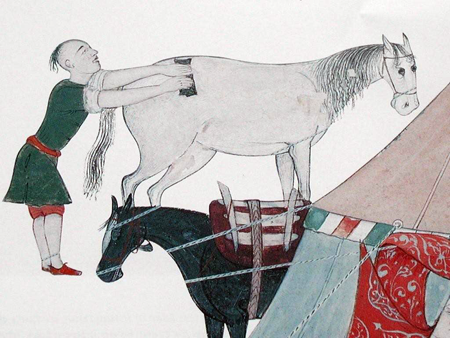LES COMPLEMENTARITES DE L’OSTEOPATHIE
Comme toute approche sensitive, l’ostéopathie est, par principe, ouverte à toute proposition thérapeutique respectueuse du cheval soigné.
Le texte de Phil Rogers exprime exactement ceci : "Holistic medicine is the best medicine for humans or animals. It embraces the best of conventional medicine, plus the best of "complementary medicine". Where necessary, it includes surgery. It attains optimal clinical results with minimal side effects to the patient and at less cost than high-tech conventional medicine. Holistic medicine examines all the interactions between the external environment and the body-mind-spirit of the patient. It does not view the Syndrome (the Lesion-Symptom Complex) as the disease per se. The Syndrome is only the clinical manifestation of the disease, i.e. the Branch, or end-result, of the body’s defensive reaction, its attempt to try to correct the Energetic Imbalance, which is the Root cause of the disease. In Chinese Medicine, Holistic medicine aims to diagnose the predisposing factors (usually energetic and/or genetic) and the precipitating factors (usually external factors, but sometimes internal-emotional factors) that trigger the Syndrome in the weak physical structures, organs or parts of the body or in the psyche / spirit of the patient. It places less importance on the Syndrome (Branch) and the weak physical structures than on the Root causes. Treating the Branch is like taking an analgesic for a headache, or an antibiotic for a bacterial infection. It may be necessary for rapid symptomatic relief, but it does NOT address the Root cause of the headache, or of the suppressed immune status that allowed the bacteria to overcome the body’s natural defences. Where possible, holistic medicine Treats the Root, i.e uses whatever methods are needed to remove, neutralise or alleviate the root causes of disease. Its modalities include acupuncture, herbal (especially oriental) medicine, homeopathy, immunostimulation therapy, osteopathy / chiropractic, nutritional supplements, dietary adjustment, advice on lifestyle, physical / mental exercises, stress control / hypnosis / relaxation therapy, etc. When indicated, it also uses conventional physiotherapy, medicine, surgery, nutrition, counselling, etc. If Root Treatment does not give the desired result, and in all syndromes that pose a serious threat to life, it Treats the Branch, i.e. to tackle the symptoms and or lesions directly. In many cases, for example in severe pain, it combines Branch and Root treatment, including helping the client to attain a more balanced mental-spiritual state." “Phil ROGERS” http://homepage.eircom.net/ progers/roghome.htm L’essence même de l’ostéopathie est de trouver la lésion primaire, la racine du mal, et de la traiter par le moyen le plus efficace : ce peut être un trouble digestif consécutif d’une erreur alimentaire, un environnement stressant, une malformation congénitale, un mauvais harnachement, une erreur de ferrure, une mauvaise piste de travail... les causes sont multiples et parfois anciennes et oubliées. Il convient de rester modeste et ouvert à toute éventualité. Il est simpliste de résumer un trouble locomoteur à, par exemple, un boulet douloureux. Pourquoi ce boulet est douloureux, quelle est la cause profonde, comment éviter la récidive et faire en sorte que le cheval vive bien avec son arthrose ? Que de réponses possibles et souvent très différentes entre les patients ! La difficulté n’est pas d’avoir des informations mais de savoir leur donner un sens et de les hiérarchiser L’acupuncture peut être une première approche sur un cheval hypertendu ou hyper algique, permettant dans la même séance une approche ostéopathique par ailleurs impossible. Ce peut être parfois la seule thérapie efficace lors d’épuisement des capacités d’autoguérison du corps. La découverte de dysfonctions majeures doit orienter l’ostéopathe vers des examens complémentaires : radiographie, échographie, endoscopie, scintigraphie, tout moyen moderne de la science à utiliser de façon bien cadrée. Il est trés difficile de cerner avec justesse ce qui est du ressort d’une manipulation ostéopathique ou non : l’expérience est d’un grand secour, mais, je crois, surtout la perpétuelle remise en question de ses choix et de son diagnostic. |
